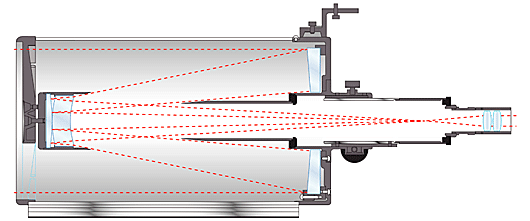Vixen VMC200L

Technical data:
Construction: Catadioptrical reflector
d=200mm
f=1950mm, f/9.75
Primary mirror: f=500mm, f/2.5
Secondary mirror: d=72mm, magnification 3.9x
Distance primary secondary:: ~330mm
Central obstruction 80mm diameter (40% of d)
Theoretical resolution (Dawes): 0.63"
Theoretical min mag: 13.3
Tube length ~525mm incl. focusser
Weight: 5.9kg
Finder scope: 7x50
The VMC features a catadioptric "Field Maksutov" type design with two spherical mirrors and a meniscus corrector element behind the secondary mirror passed twice by the light:

The open tube allows shorter cool down times compared to 8" SCTs but makes the scope more sensitive to tube current if not cooled down properly.

Adaption to Losmandy GM-8 with G11 head.
Collimation experiences
The VMC has a very robust seconday/corrector holder and spider vane and holds collimation very well. Nevertheless I managed to totally screw up collimation when playing with a holographic focussing aid (which didn't work for the VMC by the way...) and the VMC needed a complete recollimation.
The fast primary mirror makes the VMC quite 'nervous' regarding collimation, small movements of the mirros/collimation-screws have huge results.
I tried the "standard
collimation procedure for Rumak kind maksutov cassegrains"
first:
- Adjust the secondary at the extrafocal out of focus pattern
- Adjust the primary at the intrafocal out of focus pattern
- Start again with 1. until finished, do only small corrections in
each
iteration.
When I was finished I had quite nice airy discs but:
- color
- coma
- astigmatism
so something went wrong.
I inserted a chesire in the focusser and the error was obvious: The "optical
axis" I adjusted was not parallel to the ideal axis, so I tried the
idea to align the secondary as close to the optical axis as possible with
a collimation tool in the drawtube first and finish collimation at a star
adjusting the primary only afterwards. I used a Chesire to adjust the
secondary/corrector-element (no full aperture corrector in a Field-mak)
on axis (assuming the draw tube's adjustment is correct) as good as possible.
This might be even more acurate with a laser.
Then I collimated the primay at the intrafocal out of focus pattern of
a star leaving the secondary alone. Success! Color and coma were gone.
I still had some astigmatism. Fortunately it was caused by too tight push/pull
screw pairs at the primary mirror holder deformating the cell slightly.
I loosened the pairs, recollimated and finally the VMC was in tune ![]()
It's possble that there's no 100% accuray in aligning the secondary with a Chesire or laser but it should be a perfect way to start: Align the secondary first, then adjust the primary at a star and then do the very last touch-up of secondary and primary at the extra-/intrafocal star image.
The primary mirror holder of the VMC is quite sensitive regarding too
tight fastened adjustment-screws resulting in severe astigmatism. The
same is heard about the VMC's "brother" VC200L using the same
mirror holder.